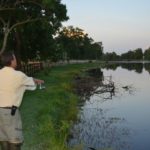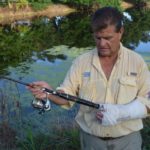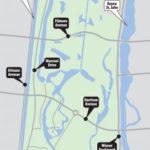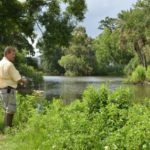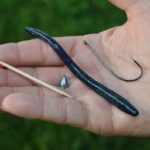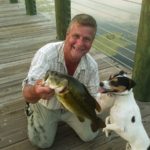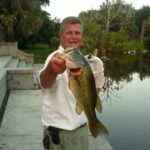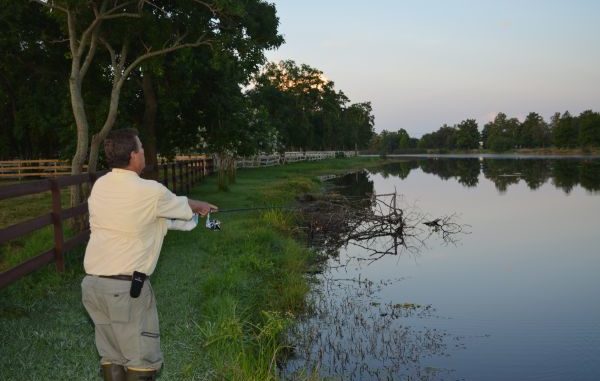
New Orleans’ City Park is a popular jogging area, but this angler knows the lakes hold a lot of bass — lunker bass. Here’s how he goes about dragging them to the banks.
I was in the heart of the urban jungle.
It was 4:30 in the morning.
The neon sign on the Morning Call coffee shop in New Orleans City Park blazed brightly, so it seemed open. But everything was dead quiet — no cars in front; no people visible inside.
I ventured to the door, half-expecting it to be locked. It swung open, revealing an impressive mounted largemouth bass on the wall of the foyer. The label beneath it said it was 7 pounds, 14 ounces and had been caught by Mike Laviolette.
Inside sat a rather disheveled-looking late-middle-aged man reading a paperback novel, who mumbled to me to sit where I wished. After a few minutes and with what seemed like a great deal of effort, he asked what I wanted.
“Coffee,” I replied. “Pure coffee — no chicory.”
Contempt for my tastes flashed across his face before he turned to shuffle into the kitchen.
I was here, of all places, to meet and fish with a special bass fisherman.
Mike Laviolette is apparently something of a mascot for two of the largest independently owned sporting goods stores in the city — Chag’s Sporting Goods and Puglia’s Sporting Goods.
He has made a name for himself by catching large numbers of big bass out of the New Orleans City Park Lagoon System.
And he has only one functional hand.
In May 2013, he was fishing just out of sight of his car when a thief riffled his car and stole all of his fishing equipment. Chag’s and Puglia’s donated three reels, four rods, two tackle boxes, a rain suit, boots and two pairs of sunglasses to get him fishing again.
Ten minutes after I arrived, the earnest, clean-cut 56-year-old sailed in the front door and headed to my table. After shaking hands, I commented about the big bass in the foyer.
“Yes, I caught that one,” he admitted modestly, adding, “I have a 7-4, a 7-12 and a 7-14 in my freezer at home for a stringer mount.”
“Wow,” I thought. “He caught those fishing from the bank of a park lagoon system in the middle of New Orleans.”
I was impressed already.
Over coffee, the affable man talked about his background, richly steeped in New Orleans tradition. As a kid, he lived within biking distance of the park, but never fished there. Rather, he and family members would fish in the marshes of Shell Beach from boats they rented from the legendary launch operator, Blackie Campo.
They sold a lot of their catch to restaurants, including the oldest and arguably the most famous of the city’s dining establishments, Antoine’s Restaurant.
“My uncle, Leroyal Pierre Martin, was the head chef at Antoine’s then,” he explained. “Four other uncles and my father Francis were all waiters there. My first job, when I was 14 years old was cleaning fish at Antoine’s.
“They bought a lot of fish from individuals in those days. I remember a bookie named ‘Blue’ who they would buy from. He fished every day. He had spots that he would fish pompano. I can remember we bought ice chests of 200 trout.”
He paused, and I interrupted to ask him how he lost the use of his hand and became a bass fisherman.
“I was working a friend’s camp at Shell Beach,” his answer began. “They hired a guy with a Bobcat to spread gravel. He backed up over me and my hand got caught in the sprocket that drives the tracks. It just pulled me in. I was jammed between the Bobcat and a piling.
“Eight hours later, they sewed me up with over 300 stitches. After a dozen surgeries, my hand resembles a cartoon characters hand with only four fingers. Only the thumb has any movement, and it’s minimal.
“From non-movement, the hand withered tremendously. I started walking in City Park for rehab. I got to thinking that I would like to fish. Actually, I started thinking about fishing while I spent 90 days in the hospital. I said, ‘If I get out of here I’ll fish every day.”
He chuckled
“Now I fish at least five days out of seven,” he said.
His Jack Russell terrier “Jackamo” is his only fishing companion.
“I developed a splint out of plastic that straps on my arm to hold the rod and stabilize it. That’s what I fish with now,” Laviolette said. “We need to go now. It’s time to fish.”
It was still dark when Laviolette parked his SUV on the corner of Marconi and Robert E. Lee boulevards on the northwest corner of the park.
I watched closely as he rigged his hand for fishing. He strapped the custom-built splint to the palm of his bare hand (sometimes he wears a four-fingered glove) with two Velcro straps. The splint had a length of PVC pipe strapped to it in turn; this served as his rod holder.
Then the entire thing was snugged securely to his hand by wrapping it with an ACE bandage.
Each of his fishing rod handles is wrapped with multiple layers of electrical tape to increase the diameter of the rod butt so that it will fit snuggly in the PVC rod holder.
Laviolette fishes exclusively with spinning rods and reels, primarily because they fit in the holder best.
The reels are rigged left-handed. He casts with his right hand, and then inserts the rod in the rod holder. He cranks the reel with his right hand for the retrieve.
It’s a system that seems to work: Since the spring of 2012, when he began fishing City Park seriously, he has caught approximately 50 largemouth bass over 5 pounds.
He pulled on rubber knee boots, not just to keep his feet dry in the dewy grass, but to protect them from fire ants, as well. He shared that a snake once crawled across the toe of his boot while he was fishing the park.
He began casting by the light of the full moon. It was still dark. Early, urban street noise dominated the senses. Off in the distance a siren wailed. Someone was having an emergency.
With dawn came other sounds — swamp sounds. The croaking of a bullfrog. A fish softly slurping its breakfast from the water’s surface. The hoarse squanking of an egret protesting our presence.
The sights were as incongruous as the sounds. Fleets of lycra-clad bicyclists with flashing headlights silently missiled by an alligator floating lazily on the water’s surface.
Since fishing the park is limited to what can be done from the bank, Laviolette targeted the ends of tree tops extending into the water and the edges of beds of aquatic plants by casting to them from an angle.
“The majority of fish I catch, I catch in stuff,” he said softly. “A lot of people who try fishing in the park use spinner baits. They get hung up a lot. I started fishing with monofilament line and I lost a lot of fish. Now I use 8- to 20-pound-test braided line.
“With that, they are coming out of there.”
He added that he only fishes with one lure, a june bug-colored Zoom Finesse plastic worm rigged Texas style on a 4/0 Gamakatsu worm hook.
“If it works, it works,” he said a little bashfully.
His favorite worm is 4 inches long, and his most-used bullet sinker is 1/16-ounce, although he says he will use heavier weights occasionally when it is very windy or when he has trouble staying in contact with the bottom.
He pegs the sinker in place with a wooden toothpick tip to keep it from looping on the line.
Laviolette seldom makes more than one cast from a spot, walking constantly and casting ahead of himself.
“Most people are lazy,” he quipped. “They make the mistake of walking to one spot and hammering it. Bass are real cognizant of what’s on the bank.”
Later in the morning, when he found fish willing to bite, he would stay in one spot and work it to death — until he had no more bites. But now, he walked and casted constantly.
“People don’t believe the kind of fish that I catch out of here, even people who live right here,” he said as he fished. “I throw all the fish I catch back except for mounting fish and the ones hooked too badly. I eat those.
“Oh yeah, they taste grea. I believe God put them there to eat them.”
Laviolette hopped in his vehicle and drove down Marconi Boulevard to its intersection with Fillmore Avenue. The culverts and pipes that drain the park system are good fishing spots, he explained, especially after rains that concentrate bait fish at them.
He called these particular culverts under Fillmore “one of my favorite spots,” and he probed them thoroughly by crawling and twitching the worm along the bottom.
The culverts yielded nothing that day, so using Harrison Avenue he moved into the interior of the park.
“You have to keep moving,” he said. “Sooner or later I will hit them.”
He bounced from spot to spot, seeming to hit points at random, although he was likely concentrating on spots that experience has shown to him were the best. He never passed a bridge without fishing it, noting that they were also bass hotspots.
He picked up a bass here and a bass there, but in no great numbers. When he got a bite, the fish usually took off with the lure — nothing subtle here. He responded in kind, with a gorilla hook set, grunting loudly.
“I made the mistake of pointing the tube of my rod holder toward the fish a couple of times. I learned you can’t do that: They will yank it right out of the tube,” he grinned.
The heart of the park is beautiful, a mixture of manicured turf and wild edges, palm trees of a half dozen different species and sprawling live oak trees. Laviolette stopped fishing to watch a great blue heron soar like a pterodactyl over a wide spot in the lagoon.
“City Park is a jewel,” he almost whispered. “Isn’t the park beautiful?”
Laviolette finally found a gang of cooperative bass in the front of the park, in the lagoon between City Park Avenue and the New Orleans Museum of Art. Every cast seemed to produce a pick-up on his worm.
He fished with ferocious intensity. I grabbed a seat on a wrought iron bench next to a palm tree and soaked in the park’s atmosphere. Joggers bouncing by stared curiously at the middle-aged man waving his graphite wand over the water.
The atmosphere was absolutely languid. Cathedral bells gonged in the distance while elderly couples surged by on their power walks. There was just enough of an overcast and breeze to keep it from getting hot.
It was easy to get drowsy — no; actually downright lazy.
My reverie was broken by Laviolette’s excited whooping and shouting. He was holding up a little bass — a lot smaller than the ones he had been catching and releasing.
“Look! Look! I caught a lottery reward bass,” Laviolette called out.
Sure enough, the fish was tagged with a biologist’s spaghetti tag. A more-perfect ending to the day couldn’t have been planned — or so I thought.
After we got into the car, he turned to me conspiratorially.
I’ve got a surprise for you,” he said.
He piloted his vehicle out of the eastern boundary of the park and down through the mansions lining Esplanade Avenue.
Three and a half miles later, we were in front of Antoine’s Restaurant on St. Louis Street in the French Quarter.
“We’re going to get the chef, Michael Regua, to prepare the bass I caught yesterday,” he announced. “At one time we probably had 10 relatives that worked here.
“All my country cousins from St. Martinville would come in and work summers.”
I felt out of place in my fishing clothes the moment we entered the rarefied atmosphere of sophistication that enveloped the 173-year old restaurant. The maître d’ seated us along a wall, beneath an autographed photo of Gen. George Patton dining there.
A dignified waiter in a crisp black suit and black bow tie appeared with two glasses of water and bread.
“Hi Ricky,” Laviolette said.
The waiter was his brother, a retired New Orleans Police captain who returned to the Antoine’s fold. (The connection between the family and restaurant must run deep. A cousin, Charles Carter, works there, as well.)
Over an exquisite Salade de couer de palmier — hearts of palm on a bed of lettuce with tomato wedges dressed with strawberry vinaigrette — I asked Laviolette about how he has dealt with the loss of the hand.
“I’m not bitter; I’m lucky to be alive,” he said. “I had an infection that wouldn’t quit and took 28 units of blood. I am self-conscious about it, though. People ask me about it all the time. I have to go through it; they cringe. It is what it is.
“One thing that I miss doing is working with tools. There are a thousand little things. It takes me twice as long to get dressed.”
Be refuses to be defined by the handicap.
“I’m not going to let it stop me,” Laviolette said. “I still hunt deer, skin them and cook them. I call myself the best fisherman — hands down!”
He grinned.
The salad was followed by bass broiled with lemon-basil sauce, bass lightly fried and served with a Colbert sauce, bass almandine served with Spanish rice and then a visit with head chef Regua in the kitchen.
Back in City Park, Laviolette dropped me off at my truck. I asked him what he was going to do the rest of the day. He looked at me, slightly cocked his head slightly to one side and answered.
“Oh, I’m going fishing — right now,” he said.
